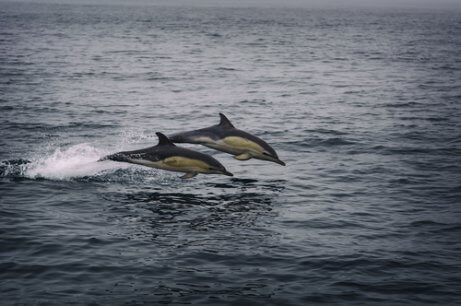Five Oceanic Dolphins

Oceanic dolphins are better known than river dolphins. We tend to associate them with fun and games, and they’re one of the most sociable marine animals. In this article, we’ll talk about five oceanic dolphins, so that you can learn more about these species.
Five oceanic dolphins
Oceanic dolphins are one of the best-known species in the cetacean family. They have large heads, long snouts, and short fins. Dolphins are strict carnivores (they eat fish and crustaceans), are very sociable and live near the coasts. Here are five oceanic dolphins:
1. Bottlenose dolphin
These are the most ‘famous’ of the oceanic dolphins, as many of them grow up in captivity and are used in shows or for swimming with people. The bottlenose or mule—which is the dolphin in the cover photo of this article—is very sociable and intelligent. They live in groups of up to 12 individuals, and they use echolocation to get their food.
These dolphins often approach swimmers or boats and follow the trails they leave in the water. Additionally, they can reach a speed of up to 7 mph, and they have to surface every eight minutes to breathe.
Also, these dolphins prefer warm and temperate climates, and they’re one of the world’s least sleepy species—they don’t rest very often.
2. Atlantic painted dolphin
This 8-foot long, robustly-built cetacean lives in the Gulf Stream and in the North Atlantic Ocean. Its name comes from the fact that the adults have a ‘spotted’ body with darker specks on their bellies and lighter specks on the sides.

They’re fast swimmers, they like to follow ships, and they’re known for interacting with people, especially in the Bahamas. Unfortunately, this makes them easy targets for harpooners and they can be victims of net fishing if they get caught.
3. Dusky dolphin
Their nicknames are Fitzroy’s dolphins and they live on the coasts of the Southern Hemisphere. In addition, as its name suggests, this dolphin is dark–almost black—on top and more of a grayish color underneath. Also, they’re medium-length (about 6.5 feet long and 220 pounds in weight), have a short nose and a prominent dorsal fin.

They’re one of the most abundant dolphins in the Argentine Patagonia and they travel to Oceania every year. In addition, they make other shorter trips of around 900 miles. Their diets include fish such as hake and anchovy, which they hunt while in their groups. Also, the dusky dolphin can form families of 200 individuals.
4. White-sided dolphin
They’re also known as Atlantic dolphins and they’re one of the most widespread ocean dolphins. They live in the cold waters of the North Atlantic Ocean (between North America and Europe). Also, they’re longer than others in their family, reaching 9 feet and 440 pounds in adults.

In addition, they can live for about 25 years (females live a little longer), gestation lasts 11 months and, once the offspring are born, they suckle for a year. Also, they’re very friendly, cheerful, acrobatic animals. They tend to approach boats, but they’re not sociable with other species. They feed on fish such as herring and mackerel.
5. Gray dolphin
Although many of the oceanic dolphins are gray, this one gets its name from its darker hue. They also have elongated markings that look like scars. In addition, they’re large (about 11 feet in length and 770 pounds in weight), have a globe-like head, and a very short muzzle.

There are no morphological differences between the sexes, they mate all year-round (especially in spring and autumn), gestation lasts about 14 months and offspring feed on their mothers’ milk for almost two years. After that, their diets include squid and small fish.
Gray dolphins group themselves in pods of up to 30 individuals. Then, they form subgroups based on sex or age. Also, they’re associated with other cetaceans such as the killer whale, the porpoise, or the gray whale. In addition, they’re usually very shy with people and boats.
Oceanic dolphins are better known than river dolphins. We tend to associate them with fun and games, and they’re one of the most sociable marine animals. In this article, we’ll talk about five oceanic dolphins, so that you can learn more about these species.
Five oceanic dolphins
Oceanic dolphins are one of the best-known species in the cetacean family. They have large heads, long snouts, and short fins. Dolphins are strict carnivores (they eat fish and crustaceans), are very sociable and live near the coasts. Here are five oceanic dolphins:
1. Bottlenose dolphin
These are the most ‘famous’ of the oceanic dolphins, as many of them grow up in captivity and are used in shows or for swimming with people. The bottlenose or mule—which is the dolphin in the cover photo of this article—is very sociable and intelligent. They live in groups of up to 12 individuals, and they use echolocation to get their food.
These dolphins often approach swimmers or boats and follow the trails they leave in the water. Additionally, they can reach a speed of up to 7 mph, and they have to surface every eight minutes to breathe.
Also, these dolphins prefer warm and temperate climates, and they’re one of the world’s least sleepy species—they don’t rest very often.
2. Atlantic painted dolphin
This 8-foot long, robustly-built cetacean lives in the Gulf Stream and in the North Atlantic Ocean. Its name comes from the fact that the adults have a ‘spotted’ body with darker specks on their bellies and lighter specks on the sides.

They’re fast swimmers, they like to follow ships, and they’re known for interacting with people, especially in the Bahamas. Unfortunately, this makes them easy targets for harpooners and they can be victims of net fishing if they get caught.
3. Dusky dolphin
Their nicknames are Fitzroy’s dolphins and they live on the coasts of the Southern Hemisphere. In addition, as its name suggests, this dolphin is dark–almost black—on top and more of a grayish color underneath. Also, they’re medium-length (about 6.5 feet long and 220 pounds in weight), have a short nose and a prominent dorsal fin.

They’re one of the most abundant dolphins in the Argentine Patagonia and they travel to Oceania every year. In addition, they make other shorter trips of around 900 miles. Their diets include fish such as hake and anchovy, which they hunt while in their groups. Also, the dusky dolphin can form families of 200 individuals.
4. White-sided dolphin
They’re also known as Atlantic dolphins and they’re one of the most widespread ocean dolphins. They live in the cold waters of the North Atlantic Ocean (between North America and Europe). Also, they’re longer than others in their family, reaching 9 feet and 440 pounds in adults.

In addition, they can live for about 25 years (females live a little longer), gestation lasts 11 months and, once the offspring are born, they suckle for a year. Also, they’re very friendly, cheerful, acrobatic animals. They tend to approach boats, but they’re not sociable with other species. They feed on fish such as herring and mackerel.
5. Gray dolphin
Although many of the oceanic dolphins are gray, this one gets its name from its darker hue. They also have elongated markings that look like scars. In addition, they’re large (about 11 feet in length and 770 pounds in weight), have a globe-like head, and a very short muzzle.

There are no morphological differences between the sexes, they mate all year-round (especially in spring and autumn), gestation lasts about 14 months and offspring feed on their mothers’ milk for almost two years. After that, their diets include squid and small fish.
Gray dolphins group themselves in pods of up to 30 individuals. Then, they form subgroups based on sex or age. Also, they’re associated with other cetaceans such as the killer whale, the porpoise, or the gray whale. In addition, they’re usually very shy with people and boats.
This text is provided for informational purposes only and does not replace consultation with a professional. If in doubt, consult your specialist.








